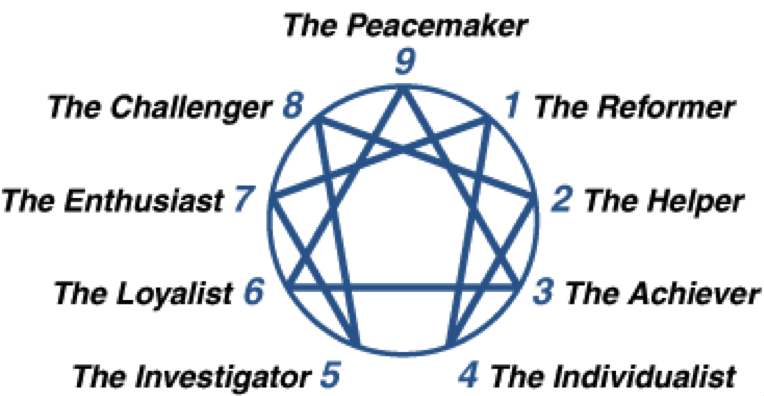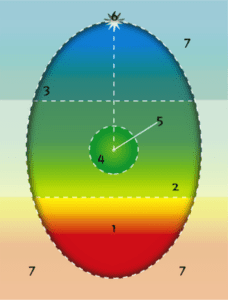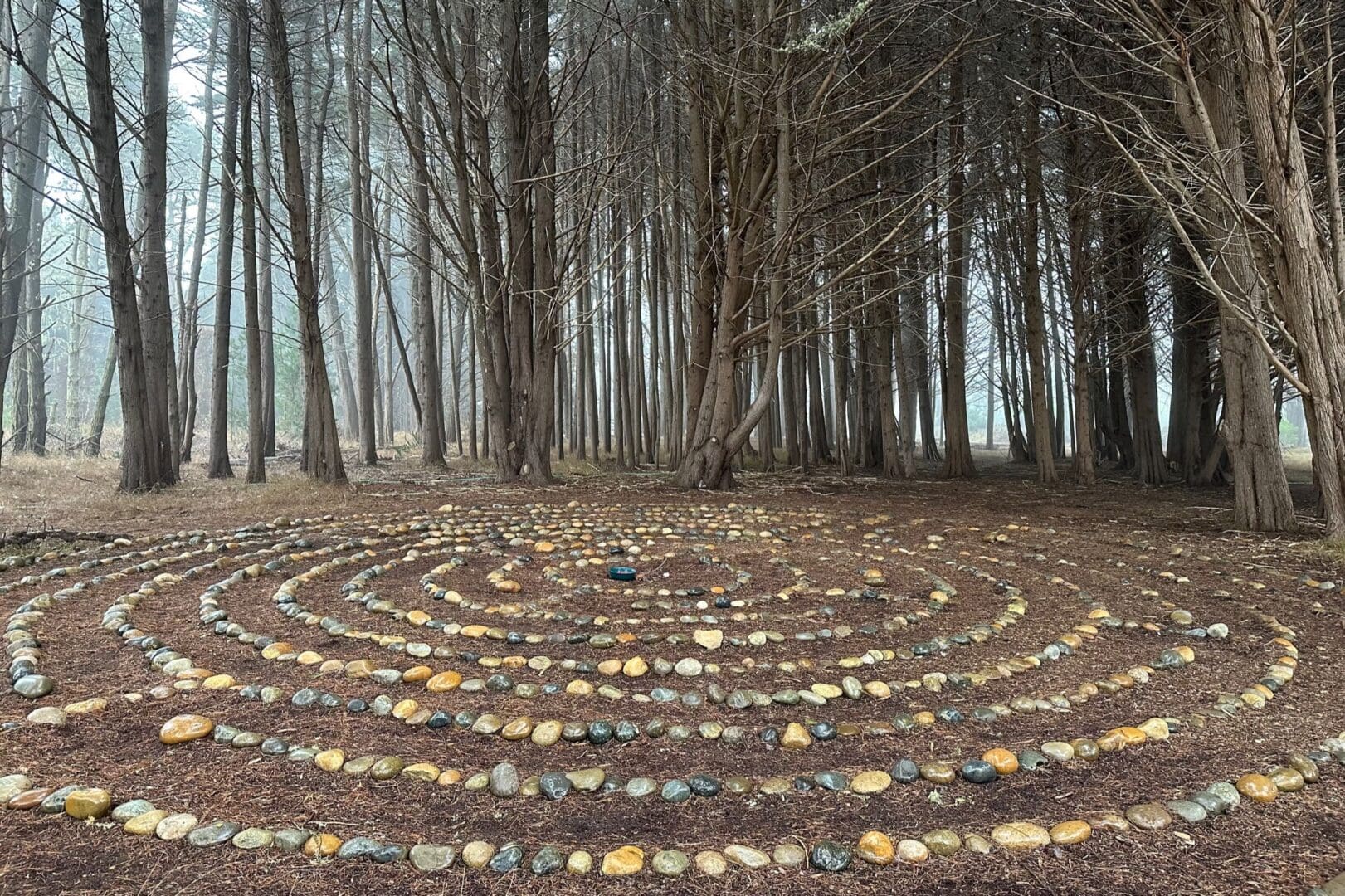I have been studying the Enneagram. Enneagram is an archetypal psychology – “a model of personality which is principally understood and taught as a typology of nine interconnected personality types,” Wikipedia tells us.
Enneagram provides those drawn to it with a tool for understanding ourselves and others in a compassionate way. When we understand the archetypes at work within us, we are less tempted to blame ourselves for how we are in the world or blame others for how they are. Enneagram also provides a tool for those working on inner evolution.
The contemporary uses of Enneagram derive from wisdom teachings rooted in Jewish, Christian, Sufi, and Greek traditions.
One of the best on-line sources is The Enneagram Institute created by Don Riso and Russ Hudson. They offer a concise guide to the enneagram. They also have as a brief free test (and a longer fee-based one) to help you begin to find your type. Riso and Hudson are the authors of the most accessible text – The Wisdom of the Enneagram –The Complete Guide to Psychological and Spiritual Growth for the Nine Personality Types.
Before reading further, you may want to look at their website.
Different authors name the nine Enneagram types differently. Riso and Hudson use the following:

1. The Reformer
2. The Helper
3. The Achiever
4. The Individualist
5. The Investigator
6. The Loyalist
7. The Enthusiast
8. The Challenger
9. The Peacemaker
It is not uncommon to have considerable difficulty discovering your type. You may well find yourself considering several. It is even more common not to “like” your type. Enneagram can uncomfortably reveal our shadow. The Enneagram tests, like the one offered by Riso and Hudson, may offer clues. I prefer to study the types rather than use the tests for guidance.
Enneagram posits that each of us develops a single core character structure in early life. Each point, or character structure, is connected to two other points that we move to either from a heart place or under stress. Each point has a “wing” relationship with one (or sometimes both) adjacent points. Each point also ranges in expression from lower to higher levels of evolution. Different investigators describe these relationships in different ways.
Enneagram was brought to the West by the spiritual teacher C.J. Gurdjieff (1886-1949). Enneagram was developed as an instrument for human transformation by Oscar Ichazo at his Arica School in Chile in the 1960s. Claudio Naranjo, a psychiatrist, learned the enneagram from Ichazo. Naranjo brought Enneagram to Berkeley where a remarkable circle of Enneagram students gathered around him.
Helen Palmer, who was part of Naranjo’s circle, brought Enneagram to wide public awareness with The Enneagram in Love and Work and The Enneagram: Understanding Yourself and Others in Your Life.
A. Hammed Ali, who uses the pen-name A.H. Almaas, is the founder of the Diamond Approach combining ancient teachings and modern depth psychology. He and his colleague Sandra Maitri were both in Naranjo’s circle. Almaas’s Facets of Unity is a brilliant contribution. Maitri has written The Spiritual Dimensions of the Enneagram and The Enneagram of Passions and Virtues, both valuable resources. Naranjo has contributed seminal enneagram studies, including Ennea-type Structures: Self-Analysis for the Seeker, The Enneagram of Society, and Enneagram in Psychotherapy.
Enneagram is taught at Stanford Business School. It is widely used in organizational development by people with no interest in its esoteric origins. It has had a powerful effect on the Jesuit imagination, as authors like Richard Rohr make clear in his fine book, The Enneagram – A Christian Perspective.
One excellent introduction to Enneagram is Beatrice Chestnut’s The Complete Enneagram: 27 Paths to Greater Self-Knowledge. Chestnut draws deeply on Naranjo’s work. According to Chestnut, Enneagram has an astonishing parallel with the lands Ulysses visits in Homer’s Odyssey. Chestnut says the lands Ulysses visits track the nine points on the Enneagram in the same order. Consider how unlikely it is that this parallel is accidental. It strongly suggests some version of Enneagram or a predecessor system was known to Homer.
There is also a close relationship between Enneagram and the Circles of Hell in Dante’s Inferno. Chestnut quotes liberally from both Homer and Dante to illustrate the character points. Enneagram tracks with the seven Deadly Sins of Catholicism (plus two). Enneagram also tracks quite closely with the Jewish, Christian, and Hermetic Kabbalistic Tree of Life, or Ten Sephirot. Consider how unlikely it is that these are random coincidences. Finally, Naranjo demonstrated that the Enneagram types track with the major contemporary psychiatric diagnoses.
The Enneagram is one of many psychological typology systems. There are interesting parallels between the Jungian Myers-Briggs (MBTI) types and the Enneagram types, although MBTI has more than double the number of types. These and other personality typology systems are explored at www.typologycentral.com.
What I appreciate about Enneagram are its ancient roots, its congruence with the Abrahamic traditions, its uncanny resemblance to the Homeric lands Ulysses visits, and its deep relationship to Dante’s Circles of Hell. These parallels suggest to me that Enneagram taps into character constructs that have been remarkably stable in Western civilization for thousands of years.
My study of archetypal psychology began with Carl Jung and Joseph Campbell. I studied James Hillman’s archetypal psychology. I also studied Roberto Assagioli’s Psychosynthesis. These studies are reflected in many New School conversations.
I find a useful resonance with Enneagram in Assagioli’s Psychosynthesis model, in which sub-personalities are arranged within a circle similar to the Enneagram circle. One can say that behind each sub-personality lies a complex, and behind each complex lies an archetype. In Assagioli, sub-personalities can be found in the lower, middle and upper unconscious. Likewise, in Enneagram, the Enneagram archetypes can ascend from low unconscious structures to evolved conscious ones. We are not prisoners of our Enneagram types. With evolution we come to encompass more types at higher levels. Likewise, with Assagioli, as we come to recognize our sub-personalities we can work more skillfully with them to move toward lower levels of intra-psychic conflict. This enables us to focus energies on life purpose. The Psychosynthesis diagram below is from Wikipedia: https://en.wikipedia.org/wiki/Psychosynthesis. Imagine the sub-personalities as small circles surrounding the center point of consciousness and distributed through the lower, middle and upper unconscious.

1: Lower Unconscious
2: Middle Unconscious
3: Higher Unconscious
4: Field of Consciousness
5: Conscious Self or “I”
6: Higher Self
7: Collective Unconscious
In summary, I find Enneagram a fascinating tool for self-study and for understanding others. I find it helpful in understanding myself, my family, my friends, my colleagues, my co-workers, and indeed all those in whom I am interested. We have already had one New School conversation on Enneagram with Bill Glenn. Bill was also kind enough to do an illuminating workshop on Enneagram with Commonweal staff. There is no organizational endorsement of Enneagram. It interests some of us and is kindly tolerated by others. I expect to have future conversations on Enneagram at The New School.
Michael Lerner



